David Weinstein, Kass Green, Jeff Campbell, and Mark Finney
ABSTRACT Research scientists and forest resource managers have long sought the ability to model wildfire behavior. Considerable effort has been directed toward understanding the science of fire behavior and developing computer- based modeling techniques for predicting fire growth. Recent advances in the field of fire science, along with the availability of high resolution remote-sensed satellite imagery, powerful image processing software, Geographic Information Systems (GISs), and affordable computer hardware has enabled the development of sophisticated, yet easy to operate fire simulation applications. A fire simulation application, FIRE! has been developed which integrates state of the art fire behavior modeling into the ArcInfo GIS environment. The model's user interface has been designed so that advanced computer and GIS skills are not required by for model execution. The model puts the power of comprehensive fire behavior prediction into the hands of qualified on the ground resource managers where it can be most effectively applied. INTRODUCTION Fire plays a very significant role in the management of pine forests of the Southeastern United States. Both wildfires and controlled prescribed burning significantly affect forest management activities from timber harvest scheduling to reforestation and thinning operations. Wildfires destroy thousands of acres of prime forest land every year while controlled burning helps to maintain a manageable fuel loading for forests susceptible to destructive wildfires. With the added complexity of managing productive forests which also support active military operations and training, monitoring and controlling both wild and prescribed fires is a particularly challenging charge for the Division of Forestry at the Camp Lejeune Marine Corps Base in eastern North Carolina. Throughout the country as well, personnel, equipment, and financial resources are tremendously strained in the struggle to contain and extinguish wildfires. Thousands of firefighters and support staff are engaged and millions of dollars are spent annually to preserve and protect human lives and personal property as well as valuable timber and recreation resources. Twelve hour work days for weeks at a time in hazardous conditions are not uncommon for wildfire fighting personnel during heavy burning seasons such as those encountered during the past several years. The continued emphasis on safety and resource protection by the numerous state and local agencies charged with combating wildfire has increased the need for more accurate and dependable tools for wildfire management. For several years, forest fire management personnel have utilized fire behavior models such as BEHAVE (Andrews, 1986) to aid in predicting fire behavior and subsequently mapping probable scenarios of fire spread during a given time period. BEHAVE is a non-spatial fire behavior prediction tool. Utilizing inputs of fire fuel type, topography data, weather data, and initial fuel moisture data, BEHAVE calculates fire behavior and fire characteristics for a given area. While BEHAVE is very useful for predicting fire characteristics for a given land area, the output is inherently non-spatial. In other words, the spread rates, flamelengths, fireline intensities, and heat calculations generated by BEHAVE are applicable only so long as the specified fuel type, topographic, and weather related parameters do not vary. As the topography or fuel model changes or as the weather patterns shift, BEHAVE results must be recalculated in order to provide an adequate approximation of fire behavior for the new input data regime. Considering the complexity of fuels, topography, and weather over a given landscape during a period of time, efficiently and accurately predicting fire behavior characteristics for a wildfire over time utilizing such techniques is inefficient and often impractical. However, through the incorporation of GIS technology, developing detailed fire behavior predictions for numerous scenarios becomes not only possible but incredibly efficient and effective. The forest fire behavior model developed for this project incorporates spatial fuels and topographic data, temporal weather and wind settings and initial fuel moistures into the prediction of forest fire behavior across both time and space. The model puts the power of sound, accurate, and efficient fire behavior modeling technology into the hands of forest fire management personnel charged with coordinating the containment and extinguishing of wildfires. The model can become one of the most effective tools for managing personnel, financial, and equipment resources for battling one of the most destructive and dangerous forces of nature. PRODUCTS REQUIRED The primary data source for the forest fire fuel model classification was Landsat Thematic Mapper imagery, geocoded and terrain corrected to UTM coordinates. Landsat TM sub-scene from Path 14, Row 36, acquired August 8, 1993, was utilized for this project. The date of imagery was chosen due to its combination of minimal cloud cover, optimum sun angle, and optimum vegetation vigor and reflectance characteristics. In addition, 1:15,840 scale color infra-red aerial photography for the study area was utilized extensively. The acquisition date of the photography was March 6, 1993. Although collected during different seasons, the aerial photography and satellite imagery were collected within five months of one another, thus minimizing the amount of landcover change occurring between the two dates of data collection. Image classification was enhanced through the use of ancillary GIS data layers. Ancillary data utilized for the forest fire fuel model classification included various ArcInfo GIS coverages representing past and present land-use and land-cover characteristics. The ancillary GIS coverages were used to help ensure quality control during iterative and final fuel model classifications. The fuel classification was further refined through the development and application of GIS models which examine the relationship between overstory vegetation types, soil types, recent forest management activities, forest fire fuels. In addition to the fuels layer, canopy density, slope, elevation, and aspect layers are direct inputs to the fire behavior model. Within the Camp Lejeune Marine Corps Base, however, the effect of topography is minimal. A total elevation change of approximately 35 feet is present on the base. Extensive use was made of field collected data, which was critical to both fuel classification and calibration of the fire behavior model. Ground data for fuels, overstory and understory vegetation cover, and tree crown cover was used to establish field training sites for image classification. The training sites were used to calibrate the computer classification of the image to the actual fuel characteristics observed on the ground. Data were collected on field data forms which include delineations of fuel type on aerial photography and draft classification maps. Field data from past prescribed burns and wild fires collected by Camp Lejeune Forestry Division personnel were extensively used in the fire behavior model calibration process. Base forestry division personnel consistently collect detailed data regarding fire behavior (spread rates, flamelengths, burn perimeter, etc.) for fires burning on the base. Global Positioning System (GPS) units are used to map fire perimeters. The fire behavior model was calibrated using this detailed data from past fires to ensure the most accurate and reliable fire behavior predictions under local conditions. The incorporation of this past fire behavior data during the fire behavior model calibration was among the most important tasks of the entire project. Calibration involves comparing predicted spread with observed fire patterns for each fuel type. The results yield an adjustment factor for each fuel type that makes model predictions more accurate for the particular fuel types and burning conditions. METHODS Fuels Layer A combined supervised/unsupervised approach was used to classify the Thematic Mapper imagery (Congalton et al., 1992). All classification work was performed using ERDAS (Atlanta, Georgia) image processing software. The imagery was classified into the thirteen models described by Anderson (1982) and two non-fuels classes. Anderson produced a similarity chart for cross referencing the 13 fuel models he developed to the 20 fuel models used in the National Fire Danger Rating System. The classifications used for this project are listed below: Fuel Model/Class Model Description/Typical Complex Grass and Grass-Dominated Models 1 Short Grass (1ft) 2 Timber (grass and understory) 3 Tall Grass (2.5+ ft) Chaparral and Shrub Fields 4 High Pocosin/Chaparral (6+ ft) 5 Brush (2 ft) 6 Dormant Brush, Hardwood Slash 7 Southern Rough/Low Pocosin (2-6 ft) Timber Litter 8 Closed Timber Litter 9 Hardwood Litter 10 Heavy Timber Litter and Understory Slash 11 Light Logging Slash 12 Medium Logging Slash 13 Heavy Logging Slash Non-Fuel 14 Water 15 Bare/Non-Flammable Each fuel model listed above is represents specific measure of fuel loading: surface area to volume ratio of each size group, fuel depth, fuel particle density, heat content of fuel, and moisture of extinction values. This description provides the necessary information for each fuel model to allow for the automated modeling and calculation of fire spread rates and other fire behavior characteristics provided in the GIS fire behavior model described below. The final raster classification of the forest fire fuel models was converted from ERDAS format to ARC GRID format for incorporation into the development and implementation of the fire behavior model. Tree Crown Closure A raster forest crown cover layer was also developed through classification of the Landsat TM imagery. Initially, "Water", "Bare/Non-Flammable", and other non-forest fuel classes previously identified in the mapping of the forest fire fuels were masked from the imagery. These areas were assigned a crown cover class of 0%. For the remaining areas, a series of unsupervised classifications was completed and labeled with one of the following crown cover classes: 1 - 20% Tree Crown Cover 21 - 50% Tree Crown Cover 51 - 80% Tree Crown Cover 81 - 100% Tree Crown Cover The resulting raster tree crown cover classification was also converted from ERDAS format to ARC GRID for incorporation into the development and implementation of the fire behavior model. The tree crown cover data layer influences the effect of wind direction and incoming solar radiation in the fire behavior model. Upon completion of the raster fire fuels classification, polygon creation algorithms developed by Pacific Meridian were utilized to convert the raster GIS coverage into an ArcInfo polygon coverage. In the coverage, each polygon was assigned a label depicting its forest fuel model class. The polygon coverage was produced to provide base forest managers with a vector coverage of fuel type which they can utilize alone or in conjunction with other vector and raster data layers for future landscape analysis projects. The polygon coverage of forest fire fuel type was not directly utilized in the fire behavior model development or implementation. Model Development Following the fire fuels classification, Pacific Meridian developed a new fire simulation application, known as FIRE!, which brings fire modeling capabilities to the ArcInfo GIS environment. FIRE! is an ArcTools-based application that allows a user to interactively specify all the required spatial and non-spatial parameters and specify the time, duration, and locations of a multiple ignition fire simulation. Vector representations of fire perimeters are graphically displayed as the simulated fire advances. Potential flat terrain spotting is computed and displayed for each perimeter. At the conclusion of the simulated burn, FIRE! also displays raster representations of time of arrival, heat, fireline intensity, rate of spread, and flame length for the burned area. Plots of the simulation results may be generated using built-in plotting templates or customized by the user with the full suite of plotting tools available in ArcInfo. All of the output data is preserved as ArcInfo coverages and grids, which may be further analyzed by the user with the full range of capabilities of the ArcInfo GIS environment. The engine of the FIRE! application, responsible for all the complex computations necessary for simulating fire behavior is FARSITE (Fire Area Simulator) (Finney, 1993), a C++ program developed by Systems for Environmental Management with support from the National Interagency Fire Center (National Park Service) in cooperation with the Fire Behavior Research Work Unit of the USDA Forest Service Inter mountain Fire Science Laboratory. FARSITE interacts seamlessly within the ArcInfo environment as a component of FIRE! enhancing the spatial display and query capabilities of the GIS for fire modeling and analysis. Figure 1 outlines a flow diagram for FIRE!.
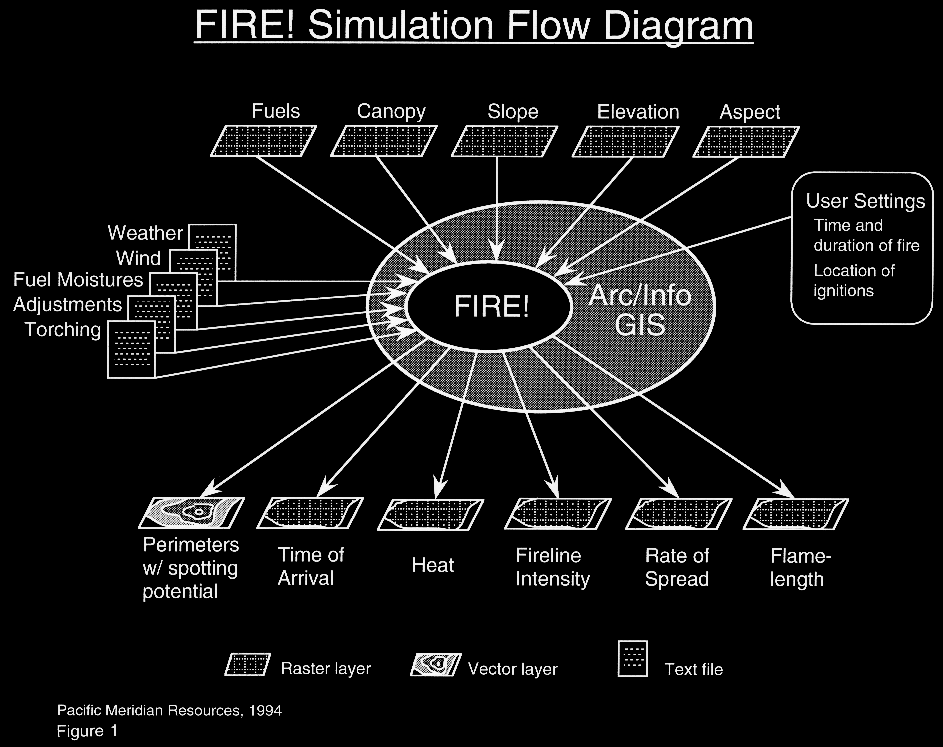
FIRE! allows a user to model fire behavior by defining a fire "scenario". The scenario is comprised of three sets of input parameters: landscape files, run parameters, and ignition locations. A Geographical User Interface (GUI) has been designed to allow the user to easily specify and edit the data and parameters necessary to execute each simulation scenario set. The first set establishes the spatial and temporal data to be utilized by the model. The user specifies the appropriate fire fuels, canopy cover, slope, elevation, and aspect layers required for the simulation. In addition, non-spatial data sets including weather, wind, initial fuel moistures, and fuel model adjustment factors can be created, specified, and edited.
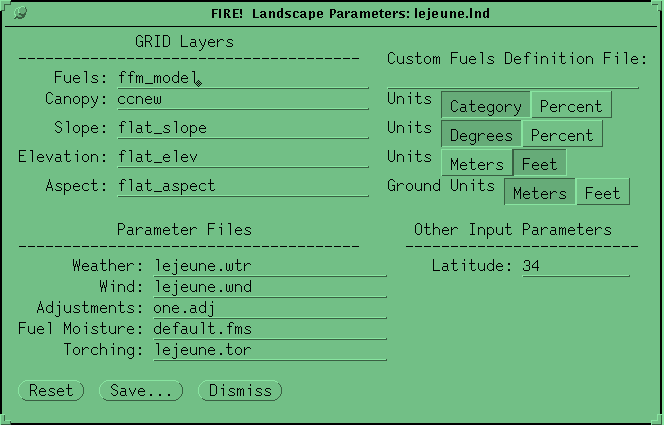
Run parameters include simulation start and end times along with the spatial and temporal resolution of fire growth calculations performed during the simulation. For instance, a spatial resolution of greater than the raster resolution may be specified for scenarios covering very large areas in which only a gross estimation of fire behavior over a long time period is desired. Specifying a greater spatial resolution reduces the computational requirements of the model resulting in a faster simulation. However, scenarios requiring detailed information regarding fire behavior throughout a simulation area should utilize a spatial resolution at least as small as the input data sets provide.
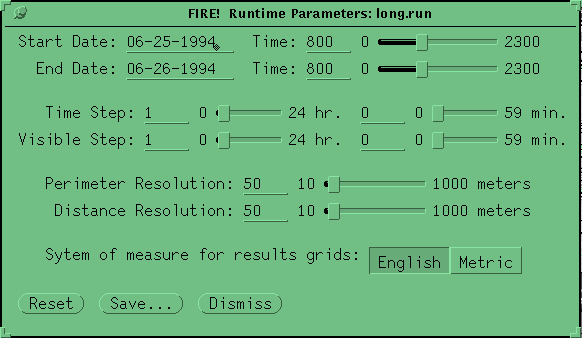
Finally, a data set identifying the location and configuration of a fire ignition must be specified. Fire ignitions may be established as points, lines, and/or polygons and are entered interactively by clicking on the screen at the desired ignition locations.
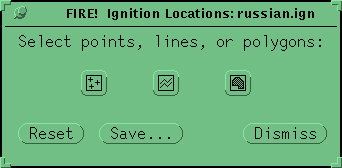
After defining the burn scenario, the model simulation can be executed. As the model performs the necessary fire behavior calculations, vectors are displayed indicating the fire's perimeter at user-specified time intervals. The vectors may be displayed over the fuels raster data layer or the original Landsat TM imagery. At the completion of the simulation, raster data layers are produced providing the flamelength, fireline intensity, time of arrival, heat per unit area, and rate of spread of the fire for every pixel within the burned perimeter. FIRE! has been designed and developed to overcome many of the shortcomings encountered with past fire behavior models. Fire modeling in the past suffered from two important limitations: the non-spatial qualities of early methods based solely on BEHAVE, and the limitations of raster-based models that followed. FIRE! employs the most recent developments in wave-based fire modeling. Wave-based models have been shown to yield the most accurate modeling results available to date. Early modeling efforts relied on BEHAVE, a non-spatial model for estimating fire characteristics, such as flame length, rate of spread, etc., for a homogeneous surface. Fire managers had to perform three labor intensive tasks manually: delineating regions of homogeneous fuel characteristics, computing BEHAVE statistics for each of these regions, and propagating the fire front based on expert knowledge of fire behavior under local terrain and wind conditions. After each iteration of manual propagation of the fire, the steps would then have to be repeated. Modern spatial techniques still use BEHAVE algorithms for computing fire characteristics while providing automated methods for propagating the fire across a heterogeneous landscape. Raster-based spatial models rely on cellular propagation methods. Cellular models use the constant spatial arrangement of a cell or raster landscape to solve for time of ignition (Finney, 1995). The fire is propagated through the raster in checkerboard steps, with cells igniting based on the characteristics of other cells in their neighborhood. Studies have shown this technique to yield distorted representations of fire shapes owing to the necessity of growing the fire from each burning cell in discrete steps in a fixed number of cardinal directions available to the grid. Vector or wave type models have been shown to closely simulate fire growth with varying winds (Anderson et al.,1982; French, 1992). Wave models recognize the inherent wave-like behavior of wildfire; that is, that the front propagates as a wave, shifting and moving continuously in time and space. Wave models solve for the position of the fire front at specified times (Finney, 1995). FARSITE uses a technique for wave propagation, known as Huygen's principle (Anderson, et al., 1982), to expand surface fire fronts in two dimensions (Richards, 1990) (Figure 5). While rasters are still used to represent the underlying landscape, and to record fire characteristics during the simulation, the fire perimeters are processed and stored as continuous vectors.
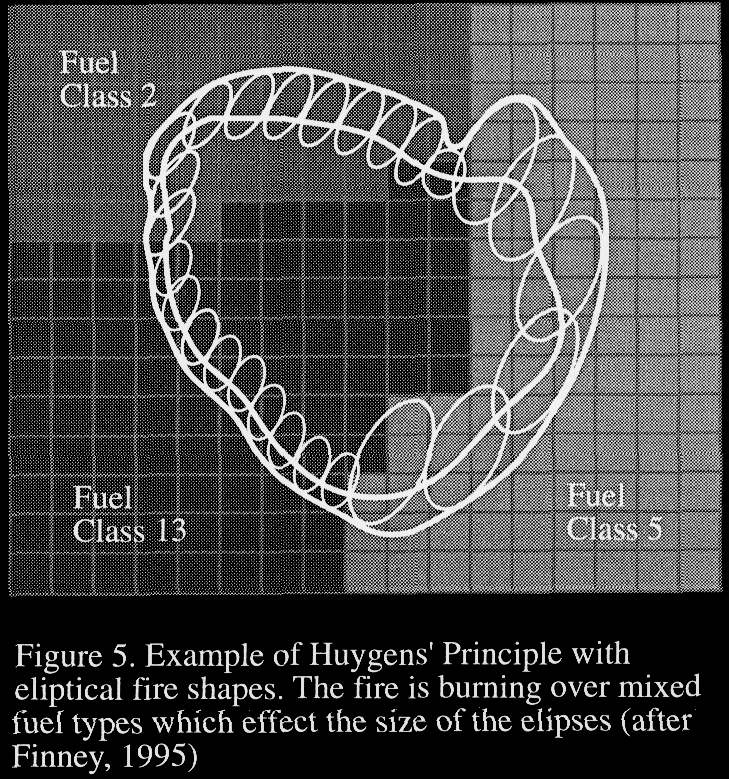
The Graphical User Interface (GUI) developed for the execution of the GIS- based model allows natural resource managers not intimately familiar with computers or GIS to effectively utilized the fire behavior model. By developing and incorporating a user friendly user interface for growth execution, this model puts the power of fully utilizing the functionality of a fire behavior model into the hands of a much wider range of resource managers and technicians. With minimal computer training and experience, nearly anyone can identify and edit the necessary input data, develop a burn scenario, execute the model, analyze the results, and produce hard copy results output without ever being required to specify command line instruction for direct computer interfacing. Outputs After defining the burn scenario, the model simulation can be executed. As the model performs the necessary fire behavior calculations, vectors are displayed indicating the fire's perimeter at a user-specified time interval. The vectors may be displayed over the fuels raster data layer or the original Landsat TM imagery. At the completion of the simulation, raster data layers are produced providing the flamelength, fireline intensity, time of arrival, heat per unit area, and rate of spread of the fire for every pixel within the burned perimeter. Figures 6 and 7 present example output files from a FIRE! simulation.

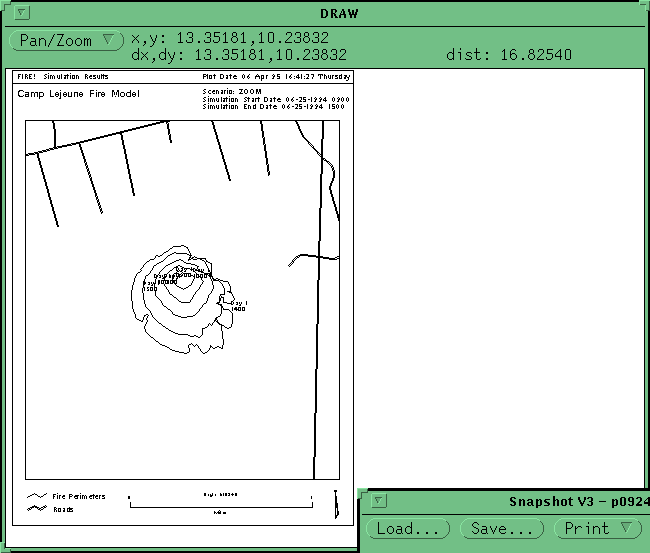
DISCUSSION While the results of FIRE! are, of course, only as good as the information and assumptions entered into each scenario. FIRE! is the first model that integrates advanced wave-based fire simulation methods with a widely utilized GIS platform in an easy to use, fully graphical environment. Some potential enhancements to the model include: improved handling of torching and spotting, with predictive techniques for simulating spot fires; real-time updates of developing weather and wind patterns recorded in the field during an actual burn; and interactive simulation of containment efforts by allowing the user to create firelines and backfires during a burn. One possible future application of FIRE! is integrating change detection analysis using digital satellite imagery with fire fuels mapping and forest fire behavior modeling. For instance, a fire fuel model classification can be developed from Landsat TM imagery for vast forested areas simultaneously. Then, using change detection analysis techniques, regions of bug killed forests may be identified and mapped again using Landsat TM imagery. By comparing the original fuels classification with the mapped areas of change due to bug kill, updating of the fuels classification may be accomplished. With the pre- and post-bug kill data sets, fire behavior analysis can be completed using FIRE! for both fuel type scenarios. This type of analysis may be extremely beneficial for evaluating the potential effects of forest management activities related to forest pest management to potential forest fire behavior. Such applications of FIRE! will allow the economic costs and benefits of resource management decisions to be considered along with ignition risk, and fire effects allowing for an informed, pro-active fire management strategy. REFERENCES Anderson, D.G., E.A. Catchpole, N.J. DeMestre, and T. Parkes. 1982. Modeling the Spread of Grass Fires. J. Austral. Math Soc. (Ser.B) 23:451- 466. Anderson, H.E. 1982. Aids to Determining Fuel Models for Estimating Fire Behavior. USDA Forest Service General Technical Report INT-122. Andrews, Patricia L. 1986. BEHAVE: Fire Behavior Prediction and Fuel Modeling System-Burn Subsystem, Part 1. USDA Forest Service General Technical Report INT-194. Congalton, R.G., Green, K., and Teply, J. 1993. "Mapping Old Growth Forests on National Forest and Park Lands in the Pacific Northwest from Remotely Sensed Data". Photogrammetric Engineering and Remote Sensing, Vol. 59, No. 4, April 1993, pp. 529-535. Finney, M.A. 1993. Modeling the Spread and Behavior of Prescribed Natural Fires. In proceedings of the 12th Conference on Fire and Forest Meteorology. October 26-28, 1993, Jekyll Island, Georgia. Finney, M.A. 1995. FARSITE. Fire Area Simulator. User's Guide and Technical Documentation. Version 1.0. Systems for Environmental Management. French, I.A.. 1992. Visualization Techniques for the Computer Simulation of Brushfires in Two dimensions. M.S. Thesis, University of New South Wales, Australian Defence Force Academy, 140 pgs. Richards, G.D. 1990. An Elliptical Growth Model of Forest Fire Fronts and its Numerical Solution. International Journal of Numerical Meth. Engineering. 30:1163-1179.
Jeff Campbell
Pacific Meridian Resources
421 S.W. 6th Avenue, Suite 850
Portland, OR 97204
Tel: (503) 228-8708 Fax: (503) 228-8751
E-mail: pmrp@teleport.com
Mark Finney
Systems for Environmental Management
PO Box 8868
Missoula, MT 59807
Tel: (406) 329-4837 Fax: (406) 329-4877